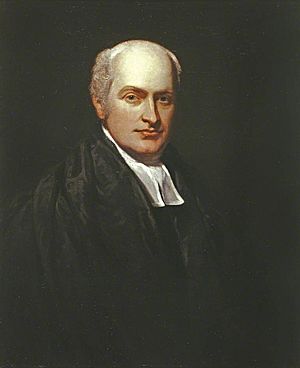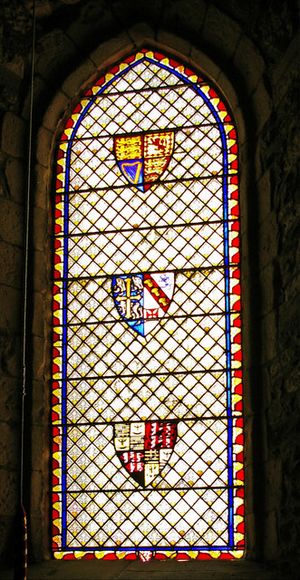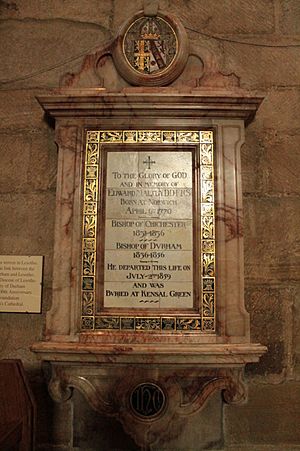Edward Maltby facts for kids
Quick facts for kids The Right Reverend Edward Maltby |
|
|---|---|
| Bishop of Durham | |
 |
|
| Diocese | Diocese of Durham |
| In Office | March 1836 (translated)–1856 (retired) |
| Predecessor | William Van Mildert |
| Successor | Charles Longley |
| Other posts | a senator, London University (1826–?) Bishop of Chichester (28 September 1831 {conf.}–1836) |
| Personal details | |
| Born | 6 April 1770 Norwich, Norfolk, Great Britain |
| Died | 3 July 1859 (aged 89) Marylebone, Middlesex, United Kingdom |
| Buried | 11 July 1859, Kensal Green Cemetery |
| Nationality | British |
| Denomination | Anglican |
| Residence | 1 Upper Portland Place (at death) |
| Parents | George & Mary née Fearman |
| Spouse | 1. Mary Harvey, 1794 (m.)–1825 (her d.) 2. Margaret Green, 1826 (m.)–1859 (his d.) |
| Children | 4 sons (with Harvey), incl. Fred. W. & Hen. J. |
| Education | Norwich Grammar School; Winchester College |
| Alma mater | Pembroke College, Cambridge |
Edward Maltby (born April 6, 1770 – died July 3, 1859) was an important English clergyman. He was a bishop in the Church of England. He became the Bishop of Durham, which was a very important position. He was known for his modern ideas and for becoming quite wealthy.
Contents
Early Life and Education
Edward Maltby was born in Norwich, England. He was the fourth son of George and Mary Maltby. His father was a weaver and a leader in the Presbyterian church. Even though his family was Presbyterian, they got along well with the Anglican Church.
Edward went to Norwich Grammar School. Later, he studied at Winchester College. In 1789, he went to Pembroke College, Cambridge. He was a very smart student. In 1792, he graduated as an "eighth wrangler," which means he was one of the top eight math students in his year. He earned his Doctor of Divinity degree in 1806.
In 1794, Edward Maltby became a personal chaplain to George Pretyman, a bishop who helped him a lot. Thanks to this help, Maltby received several church positions, including two vicarages (church districts). On July 10, 1794, he married Mary Harvey. They had four sons together.
A Time of Waiting
Edward Maltby wanted to become a bishop, but he got involved in politics too early. In 1807, he took part in a general election. In 1809, he wrote a paper that criticized the prime minister for giving jobs to family members. Because of this, the ruling political party (the Tories) did not support him for a long time.
However, a friend helped him get new roles. He became a preacher at Gray's Inn in 1817 and Lincoln's Inn from 1824 to 1835. These jobs gave him time to teach students privately. Some of his famous students included:
- Edward Bouverie Pusey
- Edward Hall Alderson
- Charles James Blomfield
He also wrote a collection of hymns in 1815. His first wife, Mary, passed away in 1825. He then married Margaret Green in 1826. Maltby was also active in a group called the Society for the Diffusion of Useful Knowledge. He was a leader at the new London University (now University College London). He even helped with the ceremony when the main building's first stone was laid in 1827.
Becoming a Bishop
When a different political party, the Whigs, came to power in 1830, they needed more supporters in the House of Lords. They thought Edward Maltby would be a good supporter if he became a bishop. In 1831, a bishop named Folliott Cornewall died. The prime minister quickly moved another bishop to that role and then appointed Maltby as the new Bishop of Chichester.
This appointment happened so fast that people were surprised. But the prime minister was happy because Maltby was able to vote to support the Reform Act 1832, which changed how people voted.
In 1837, Maltby became the Bishop of Durham. This was a very important role. He was the first bishop of Durham after the special title of "Prince-Bishop" was removed. In 1847, a close friend suggested he become the Archbishop of York, but Maltby felt he was too old for such a big job.
Helping Durham University
Maltby had a strong connection to the University of Durham. He gave a lot of his own money to help the university. He also helped with the university's royal charter, which is like an official permission document. He made sure that students still had to agree to certain religious statements before they could graduate.
His predecessor, William Van Mildert, had planned for the bishop's home to move to Auckland Castle. This allowed the university to use Durham Castle as a college. Maltby made sure the necessary repairs and changes were done for the university to move in by 1837.
Wealth and Later Life
In 1836, a law was passed that set a maximum yearly income for bishops at £8,000. However, in 1847, it was found that Maltby was earning around £12,000 a year. In 1841, he had even earned over £21,000! This caused some public criticism. In response, he started the Maltby Fund to help pay for building projects in the Durham area.
In 1855, when he was old and almost blind, Maltby asked to retire. This was very unusual for a bishop at that time. He also asked for a yearly pension of £4,500. The prime minister was not happy about this request, but he eventually agreed. This also allowed another bishop, Charles Blomfield, to retire at the same time.
Edward Maltby died at his home in London on July 3, 1859. He is buried in Kensal Green Cemetery in London, in a family burial place. There is also a special plaque in Durham Cathedral to remember him.
Honours and Achievements
Edward Maltby received several important honours during his life:
- He became a Fellow of the Royal Society in 1824. This is a very old and respected group for scientists.
- He became a Fellow of the Society of Antiquaries in 1834. This group focuses on history and old things.
Images for kids




